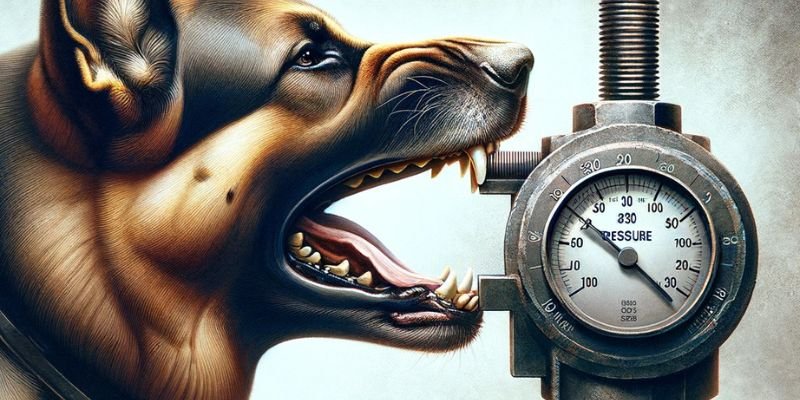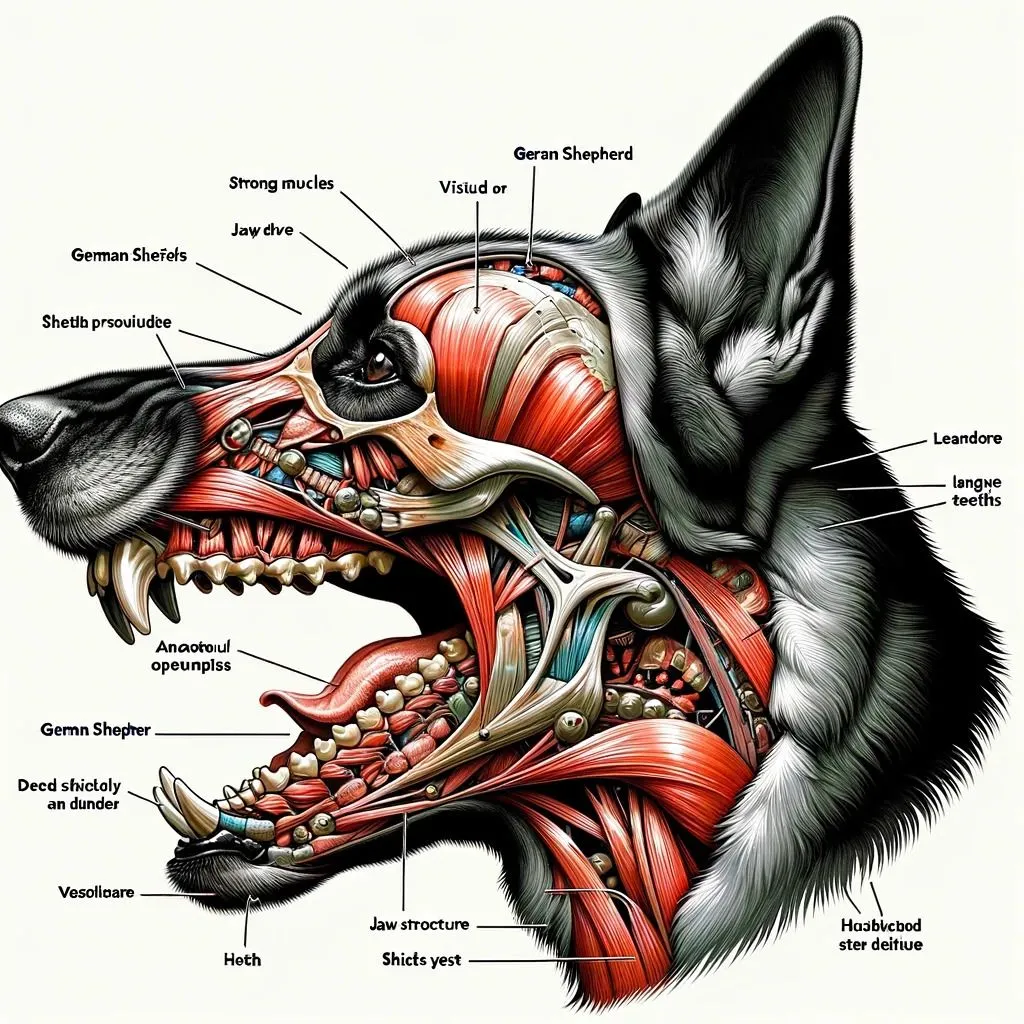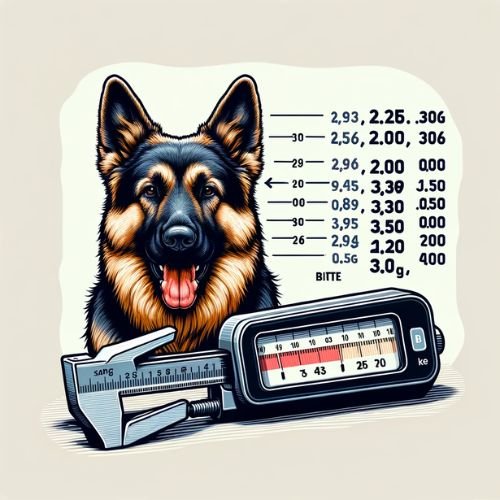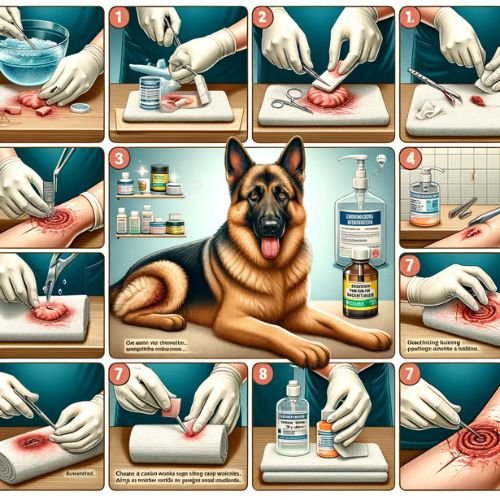As the owner of one of the world’s most popular dog breeds, the German Shepherd, I’ve realized how complex their behavior can be. These dogs are incredibly loyal and naturally defensive, making them excellent companions and protectors.
One significant aspect that intrigues many is the ways the German Shepherd teeth bite—how hard can they bite, and what factors into that strength? Questions about the impact of age, size, type, training level, and even the dog’s unique personality always arise.
This section will dive into this topic to find answers to these burning questions. Without wasting any more time, let’s jump in and discuss the biting power of a German Shepherd and what it entails.
How strong is the German Shepherd’s bite?
When measuring the potential of a German Shepherd’s bite, one must consider the force they can exert, which can be pretty substantial. On average, a German Shepherd’s bite force is estimated to be between 175-238 pounds per square inch (PSI), putting them in a higher echelon of domesticated dogs regarding strength and potential damage.
This pressure exceeds the average dog’s bite force of 130–175 PSI. Notably, German Shepherd bites are among the most forceful, rivaling those of other strong dog breeds like Rottweilers and Pit Bulls. With such a powerful bite, the risk of injury is a legitimate concern for owners.

Strong is the German Shepherd’s bite.
Owners must prioritize proper training, socialization, and constant supervision to ensure their dogs behave safely in various situations. Whether protecting their human companions or interacting with other people and animals, these preventative measures can significantly enhance the dog’s well-being while reducing the risks associated with their natural bite strength.
What is a dog bite force?
| Breed Name | Bite Force (PSI) |
| German Shepherd | 238 |
Before we continue exploring the topic of a German Shepherd’s bite force, it’s essential to answer some fundamental questions regarding what a dog’s bite force is and how it is measured. The term “bite force” refers to the pressure exerted when a dog is biting and is commonly measured in pounds per square inch (PSI).
This measurement varies across breeds, sizes, ages, and health conditions. For instance, extensive studies have shown that more substantial breeds, like the German Shepherd, can exert much higher pressure than smaller dogs. Similarly, age and health can significantly impact a dog’s bite force; younger and healthier dogs typically have a stronger bite.
Knowing the potential damage a dog can inflict is essential in assessing the risk they may pose in various situations. This knowledge informs the training and behavioral guidelines for guiding owners and trainers in effectively managing their dogs’ behavior.
How is dog bite force measured?

Measuring a dog’s bite force, typically expressed in pounds per square inch (PSI), provides insight into the pressure exerted when a dog bites. This unit reflects the pressure distributed over one square inch of area. It is crucial to understand the potential power behind a bite, which can be powerful and dangerous if not properly managed. Scientific research into dog bite force usually involves using specialized tools, such as a punch gauge meter, designed to measure the maximum force a dog’s jaws can generate. This is done by prompting a dog to bite on two metal plates attached to an instrument, recording the pressure.
While getting an exact measurement without the dog failing to bite at full strength may be difficult, this method reasonably approximates the maximum bite force. This valuable data informs training and behavioral guidelines, especially for breed owners with a reputation for strength, to ensure that interactions remain safe and controlled.
How do dogs determine their bite force?
| Breed Name | Bite Force (PSI) | Size Category | Temperament | Other Notes |
| German Shepherd | 238 | Large | Confident, Courageous | Used in police and military roles |
Numerous important factors impact the force of a dog’s bite, which is a complex issue. Foremost among these is the breed, as different breeds exhibit varying jaw structures and inherent muscle strength, which can significantly affect bite force. For example, while a German Shepherd’s bite force typically ranges from 175-238 PSI, a Rottweiler may exert much greater force, from 328-500 PSI, due to differences in breeds.
Other significant factors include the dog’s size, age, and overall health, which can all profoundly impact bite strength. The development of specific muscles in the jaw, such as the temporal muscle, masseter muscle, digastric, and pterygoid muscles, contributes to a dog’s biting capability. Dogs regularly training for protection work or guard duty may develop these muscles more, leading to a higher bite force.
Furthermore, body weight and skull morphology play a role; larger or giant breeds with heavier bodies typically possess stronger jaw muscles because of their size. It’s also essential to recognize the impact of training and behavior on a dog’s bite force. Proper training can help regulate a dog’s natural power, emphasizing its role in their bite’s safety and controlled use, particularly in breeds trained for protection.
The 6 levels of a dog bite
Understanding the degree of canine bites is critical for recognizing a dog’s potential risk and implementing appropriate training and prevention strategies. These are commonly categorized into six levels, ranging from non-injurious to potentially life-threatening:
- Level 1 (Non-Injurious Bite): This is the first and lowest tier in the scale of dog bites, often described as a warning bite. The dog may snap or mouth a person without causing any physical harm. This type of bite is typically how a dog communicates discomfort without intending to inflict injury.
- Level 2 (Low-Injury Bite): The second type involves minimal damage, with possible teeth marks on the skin but no puncture. Although the injury is usually superficial, it signals that the dog is willing to use its teeth.
- Level 3 (Moderate-Injury Bite): The third level represents an average injury, which may result in deep cuts and require medical stitches. This indicates a more serious behavioral issue that requires prompt attention.
- Level 4 (High-Injury Bite): Representing the fourth level, this high-injury bite is significantly more painful and involves deep wounds affecting the skin and possibly the underlying tissue.
- Level 5 (Severe-Injury Bite): The fifth level of dog bites is characterized by severe trauma. These are life-threatening injuries that demand immediate medical attention.
- Level 6 (Extreme-Injury Bite): The sixth and final level of bite is an extreme injury where the bite may result in broken bones, major trauma, and, in rare cases, death. It is an infrequent but severe type of bite.
For each level, it’s important to note that different breeds have varying bite forces, and the individual strength of a bite can vary even within the same breed, like German Shepherds. Understanding the six levels of dog bite injury is crucial for dog owners and victims alike, who should seek medical attention even for the lowest level of dog bite to prevent severe consequences if not treated correctly and immediately.
What makes the German Shepherd bite so powerful?

The German Shepherd’s bite is known for its raw power, mainly due to the breed’s strong jaw muscles and a well-defined skull structure—attributes that lend a formidable grip and precision to their jaws. When German Shepherds clamp down on prey or objects, they can exert an incredible force, typically measured between 175 and 238 PSI.
These dogs have broad muzzles and large heads, providing strength and leverage to their bites and intensifying their bite force. Training is essential to ensure these powerful canine companions learn to respond to instructions from handlers and acquire socialization skills, thus highlighting the significance of basic obedience training and behavioral guidelines for safety. When given proper training and treated with love and respect, German Shepherds can understand the use of their strength, allowing handlers to make informed decisions on pet behaviors in various living scenarios.
Insight into the German Shepherd’s bite force emphasizes the importance of proper training and socialization from early stages to mitigate the impact of their bite power. These powerful creatures can be handled with kindness and respect, fostering a safe bond between humans and their four-legged friends.
Do German Shepherds have the most vital bite force?
| Breed Name | Bite Force (PSI) | Strongest Bite Force |
| German Shepherd | 238 | True |
| Labrador Retriever | 230 | False |
| Bulldog | 210 | False |
| Beagle | 235 | False |
| Poodle | 220 | False |
While German Shepherds are renowned for their robust jaw structure, allowing them to exert a significant bite force of between 175 and 238 PSI, they do not possess the most substantial bite amongst canine breeds. Several other breeds exhibit even higher levels of power. For instance, the Rottweiler and the American Pitbull Terrier have demonstrated formidable strength in their bites, with forces that can reach up to 328 PSI, showcasing their intense potential.
Among the list of dog breeds with solid bite forces, the Kangal, a shepherd from Turkey, stands out with one of the most vital recorded bite forces of around 750 PSI. This breed is indispensable in its role of protecting livestock against large predators. Similarly, the American Bulldog exhibits a strong biting capability, comparable to the Doberman Pinscher, with Dobermans generating a bite force between 245 and 328 PSI.
The German Rottweiler represents a variation from the standard Rottweiler, with consistently high bite force readings. Additionally, the mastiff, specifically the English mastiff, possesses powerful jaws capable of delivering a staggering bite force ranging from 500 to 600 PSI.
Not to be disregarded is the Belgian Malinois, regularly hired by police and as a running dog, whose chew force degrees from 195 to 250 PSI. Their bite is particularly impressive, given the breed’s aptitude for performing various tasks requiring finesse and strength. Each of these breeds demonstrates the vast range and diversity of bite forces among canines, underscoring the importance of responsible ownership and training to ensure the safety of humans and animals.
German Shepherd bite force in kg.

The powerful bite of a German Shepherd, a dog breed distinguished by its massive head and extensive muzzle, is a force to be reckoned with. German Shepherds have noticeably advanced jaw muscle tissue, contributing to a biting pressure of approximately 238 PSI, translating to roughly 108 kilograms.
For perspective, the average human chunk pressure rests rounds 86 PSI, or 39 kilograms. Measured in stress, a German Shepherd’s chunk equals about 1,250 Newtons. It is vital to note that the biting pressure of a canine can be influenced with the aid of several factors, such as breed, physical attributes, the individual dog’s length, age, and health.
Owners and trainers must understand these factors to ensure their dogs’ safety in human-animal interactions.
Do German Shepherds lock jaws?
Contrary to some myths, German Shepherds do not possess the ability to “lock” their jaws. This characteristic is often misattributed to various dog breeds. Still, it is a trait associated with species such as alligators and crocodiles, with a distinct mechanism allowing them to hold onto their prey tightly.
Despite the absence of a mechanical “locking jaw,” German Shepherds are known for their powerful bite force due to their muscular jaws. This impressive strength can cause serious injury if not handled correctly. According to the Animal Farm Foundation, studies by Dr. I. Lehr Brisbin of the University of Georgia confirm that even American pit bull terriers, often claimed to have “locking jaws,” do not possess any unique mechanism or morphological differences to allow for such a trait.
It is crucial to understand the capabilities and limitations of the German Shepherd to promote responsible ownership and prevent misinformation.
Why does my German Shepherd bite so much?
German Shepherds, like many young dogs, may exhibit a penchant for biting and mouthing due to their intuitive nature. Historically bred to herd and protect, these behaviors may be expressed in a home environment as biting or mouthing behaviors, which are often a sign of boredom, anxiety, or a lack of proper training. Training your GSD puppy early on is essential to prevent these actions from developing into more severe behavior issues.
Positive reinforcement training is highly effective; this involves discouraging biting by praising and rewarding the puppy with treats, verbal affirmations, or playtime when they stop the behavior. A firm “no” guiding them towards alternative behaviors, such as fetching a toy, can also refocus their attention.
Here are some tips to help reduce biting:
- Early Socialization: Introduce your GSD to various people, animals, and environments at a young age. This builds confidence and reduces fear-based aggression while teaching appropriate social behavior.
- Obedience Training: Work with a professional trainer, if necessary, to teach your dog essential commands like “sit,” “stay,” and “leave it” to maintain control over their actions and set clear expectations.
- Bite Inhibition: Teach your GSD to control the force of their bite during play. Allow gentle mouthing, but discourage hard bites by reacting with a yelp and withdrawing attention.
- Chew Toys: Offer a variety of chew toys to satisfy their natural need to chew and prevent destructive behavior towards furniture and belongings.
- Exercise: Ensure regular physical exercise and mental stimulation. A tired dog is less likely to be aggressive or frustrated.
- Crate Training: Use a crate to provide your GSD with a safe and calming space. This can reduce stress and anxiety-related biting in a controlled environment.
- Supervision: Always supervise interactions with children, strangers, and animals, and be ready to intervene if aggressive behavior is observed.
- Social Interaction: Encourage controlled and positive interactions with other dogs to help build their social skills and reduce territorial aggression.
- Avoid Rough Play: Don’t escalate aggressive biting by avoiding stimulative rough play. Teach appropriate play boundaries.
- Seek Professional Help: If biting persists or worsens despite your efforts, consult a professional dog trainer or behaviorist for personalized guidance and a tailored behavior modification plan.
- Neuter/Spay: Consider spaying or neutering your dog. Please discuss the appropriate timing for this procedure with your veterinarian, as it can reduce the hormonal influences that may cause aggressive behavior.
Why may German Shepherds bite you?
German Shepherds may bite for various reasons, typically reacting to specific situations. If they feel scared or threatened, they might respond by biting. Lack of proper training can also lead to aggressive behaviors, including biting. Sometimes, if a German Shepherd is in pain, sick, or injured, it might bite due to discomfort or fear.

May German Shepherds bite you
Additionally, if they have not been socialized well, they might not know how to interact safely with people or other animals, leading to biting as a defensive action. It’s crucial to provide German Shepherds with consistent training, socialization, and care to minimize the risk of biting.
Do German Shepherd bites hurt?
German Shepherd bites can be severe due to their strong bite force, which ranges from 170 to 238 pounds per square inch (psi). When they clamp down hard, the sheer power of their jaws can cause significant damage. Owners and handlers must take biting incidents seriously, whether accidental or playful.
The breed’s predatory, solid instincts can sometimes lead to bites that are more forceful than intended, underscoring the importance of proper training and management to prevent such occurrences. Even though a playful nip may seem harmless, it’s crucial to address every instance of biting to ensure it does not escalate or lead to more severe injuries.
How to Treat a German Shepherd’s Bite Wound

When treating damage caused by a German Shepherd, expertise in canine bite wound technique and treatment is important. Due to their powerful jaws, accidents from German Shepherd bites can be excessive and require on-the-spot attention, just like the ones inflicted by different big dogs with solid bite forces, including pit bulls or Dobermans.
Initial wound management should begin with seeking care from a healthcare physician, who will take the patient’s health history into account. They will need to know about any pre-existing conditions that could increase the risk of infection or complications; this is critical information to gather. Questions will likely be asked regarding the patient’s tetanus immunization status, medication allergies, and the date of their last tetanus booster.
What does a German Shepherd bite feel like?
A German Shepherd’s bite is usually quite painful due to their strong jaws and sharp teeth. It can feel like a severe, quick pinch or intense pressure. The experience is often startling and can cause immediate acute pain, followed by aching.
Their bites can result in bruises, deep cuts, or more severe injuries, depending on the severity of the bite. The surprise and fear of being bitten can amplify the pain and discomfort. It’s essential to approach and interact with German Shepherds cautiously, especially if they are unfamiliar or show signs of agitation.
The top 10 dog breeds with the most potent bite force.
The most potent bite force across different dog breeds is a topic of much fascination and is often measured in pounds per square inch (psi). While not an official ranking, here is a list of dogs that are frequently highlighted for their potent bite:
- Kangal: With a bite force of approximately 750 psi, the Kangal tops the list and is renowned for its loyal and protective nature.
- Bandog: A close second, with an estimated bite force of 730 psi, the Bandog is known for its immense power and strength.
- Cane Corso: This robust and muscular breed has a notable bite force of around 700 psi.
- English Mastiff: Known for its grand size, this breed possesses a bite force of about 556 psi.
- The Tibetan Mastiff: originates from Tibet and boasts a significant bite force of roughly 550 psi.
- Wolf dog: A hybrid between a wolf and a domestic dog, it has a bite force of around 406 psi.
- Rottweiler: This popular breed has a strong bite with a force of about 328 psi.
- American Bulldog: Known for its courageous and muscular build, it has a bite force measuring approximately 305 psi.
- German Shepherd: A versatile and intelligent breed, the German Shepherd’s bite force is estimated at 238 psi.
- American Pit Bull: Often misunderstood, this breed demonstrates a bite force of about 235 psi.
It’s important to mention that these results are not official and may be for less popular breeds with a more potent bite force not included in this list.
.
Final words on German Shepherd Teeth Bite
While the German Shepherd boasts an impressive bite force and can inflict severe injury when provoked or threatened, it’s important to remember that not all bites from this breed are as forceful as those from other breeds topping the list. However, this does not mean the breed’s bite should be taken lightly.
Understanding your pet’s body language and principles of behavior can prepare owners to prevent potential biting incidents. A well-trained and socialized German Shepherd is less likely to react aggressively unless scared or uncomfortable. The key to ensuring the pet’s and others’ safety is responsible ownership and recognizing the signs that may precede a bite.
FAQs
How hard can a German Shepherd bite?
A German Shepherd’s bite force is impressive, measuring around 238 pounds per square inch (psi). This powerful jaw strength is among the highest among domestic dogs. It’s a trait that makes them excellent guards and service dogs.
How much damage can a German Shepherd bite do?
A German Shepherd’s bite can exert over 238 pounds of pressure, which is powerful enough to break bones and cause serious injury. The extent of damage depends on the duration and intensity of the bite. Immediate medical attention is often required to treat the wounds and prevent infection.
Which dog breed has the most substantial bite?
The bite force of a dog is usually measured in pounds per square inch (psi). The breed with the most substantial bite is believed to be the Kangal, with a bite force of around 700 psi. Larger breeds generally have more significant bites, with the Mastiff and Rottweiler following closely behind.
Why does my German Shepherd snap at me?
German Shepherds may snap due to fear, possessiveness, or discomfort. It’s important to identify triggers and work on training. Consulting with a professional dog trainer or behaviorist can provide tailored guidance and prevention strategies.
